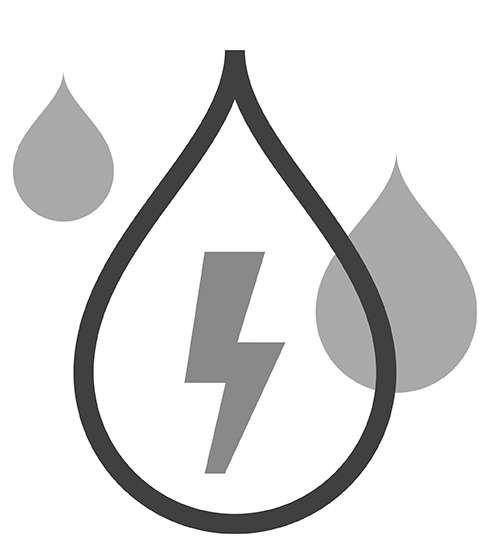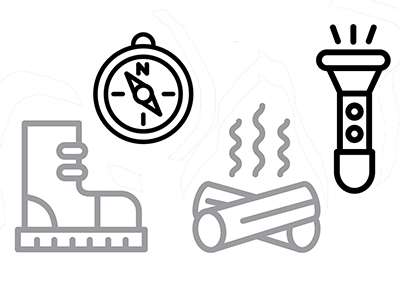Off-Grid Survival for You and Me
A guide to maintaining your own basic power, water, and supplies

This article is part of Reason's special Burn After Reading issue, where we offer how-tos, personal stories, and guides for all kinds of activities that can and do happen at the borders of legally permissible behavior. Subscribe Now to get future issues of Reason magazine delivered to your mailbox!
My family lived in a suburban garden apartment during the New York City blackout of 1977, when just two lightning strikes zipped millions of Americans back to the 19th century for roughly 24 hours. We had left the city several years earlier—fortunately, considering the rough ride urban residents had during that outage. Up the river in Tarrytown, we just congregated on the communal porch to light grills, share gossip, and bum any available candles. I can still remember the hiss of the Coleman gasoline lantern my parents had packed away with a companion camping stove. That thoughtfulness on their part allowed us luxury that those hooked on electricity flowing from far away had to do without.
When it came to unexpectedly losing some perks of modern civilization, we thrived because we were prepared. "Prepping" has gotten a bad name because of the loony obsessives on TV. But exhibitionist nuttiness aside, prepping is nothing more than extending to the rest of your life the same foresight that compels you to keep a spare tire and a first aid kit in your car, and maybe a puncture kit and a compressor, too.
A sensible prepper enjoys the convenience and predictability of everyday life but doesn't assume it will never be interrupted. Done right, prepping means you're not a burden on your neighbors, and can maybe help them out in the clutch—all because you did something as simple as storing fuel and a camping lantern.
The grid is amazing and wonderful. Wanting to survive off it doesn't mean you hate civilization. It means you love the conveniences of modern life enough that you've learned to provide some of them yourself.
Electricity

I've taken my own family even farther away from New York City, to rural Arizona. Because of that love of both civilization and independence, I'm immensely frustrated by the hurdles I've hit in trying to harness for my family's purposes that blazing ball of energy that hovers over the state. Solar power, right? It's a natural for a desert dweller. Shouldn't a nut like me, who does not want to be at the mercy of storms, lightning strikes, and low-probability disasters, have solar panels on the roof instead of a natural gas generator next to the house?
Turns out energy independence, even just for short emergencies, is a lot easier if you build from the ground up rather than retrofitting an existing structure to run off whatever juice you can self-generate. You can plan a new house to be thermally efficient, reducing heating and cooling needs, and you can equip it with appliances that sip instead of guzzle power. But if, like me, you buy a home designed to be plugged into the larger electric system, your options are limited.
Most solar installations are meant to be grid-tied and make sense only if electric utilities buy the resulting power from you. If you actually want to use the electricity yourself, you'll need to store it for when the sun sets. Solar panels and wind turbines are thus usually used to charge batteries, which are in turn used to power your TV and laptop. (Outside the desert, hydropower with a reliable year-round water source can free you from the need for battery storage.)
Because of that blazing ball of energy, we have big air conditioners in Arizona. And air conditioners, like a lot of appliances, require a starting surge to get the motor going. That surge can easily be triple the normal running load. Your battery stack must be able to accommodate that requirement for any motors you plan to plug in, and that costs money—a lot of money.
I had two companies bid on solar installations for my house. The price, including panels, batteries, inverters, and the like, came in at $30,000–$40,000. The lion's share of that amount was for the batteries.
Tax credits would've offset part of the cost. So would selling my excess power to the utility company in years to come. (This assumes the legal situation doesn't change; for now, most states require utilities to buy solar power generated by individuals.) But I wanted a backstop for occasional power outages and scarier what-if scenarios, not to explore the unlikely charms of personal bankruptcy or to dip my toes into a politically mandated market.
For a fraction of the cost of solar, therefore—about five grand plus installation, with fuel costs varying depending on market prices and how often the local grid chokes—I installed a 22-kW natural gas generator that runs everything in my house. We still have to rely on the flow of fuel, but that should be fine through most storms. It's true that natural gas is pressurized by pumps that, in some areas, rely on electricity (though in other places they're also gas-driven). Gas also moves through aging pipes that can be vulnerable to such disruptions as large storms, earthquakes, and, according to a March 2017 report in the Oil and Gas, Natural Resources, and Energy Journal, cyberattacks. But our backup has already seen us, our refrigerated goods, and our well pump through several outages. Yes, and the air conditioner, too.
When choosing a generator, "match your power needs to the size of the generator you buy," Consumer Reports advises. My parents picked an 8-kW standby generator that has kept lights and sump pump going through power outages as long as a week. But when a nasty tropical storm returned their D.C.-area community to the swampy conditions whence it emerged, they said they wished they'd picked a machine with enough capacity to run the A/C and keep the house a tad more habitable. (Running grid power to the nation's capital was a mistake to begin with, if you ask me. Climate control allows riffraff of undersecretarial depravity to skulk in the vicinity year-round.)
I do have a folding solar panel and lithium battery for juicing up various gadgets. It travels with me in the car and—if I'm in the mood to be connected—when I hit the trails. Solar definitely still has its uses, and I'm planning now to harness it to add a backup to my house's backup. If I rein in expectations and accept a solar setup that can power just the necessities, such as a refrigerator, some lights, and a few small appliances, the whole thing can be kept to a reasonable size and price.
As in most areas of life, there's no one-size-fits-all solution. Plenty of people might want to go full-hog for generating their own power, making all the necessary adjustments to their homes to do so. Others think I'm nuts for worrying about a power backup at all when cheap electricity is almost always a switch-flip away. But my approach gives me peace of mind to offset the risks of our occasionally shaky power grid. All it takes is a generator rumbling, barely audibly, next to the house.
Water

Man cannot live by electricity alone. Especially in the parched desert, where the water level in your well is far enough below the surface that you start to wonder if you've drilled into the communal Jacuzzi of the mole people, the wet stuff rightly takes up major space in your brain. It rains, blessedly, even in Arizona, so I've learned to tap my rain gutters and store the proceeds for use in the garden and as a backup to the well—important, since I can only run the pump if the grid is up or the generator is running.
Unlike some states, Arizona actively encourages the harvesting of rainwater—the University of Arizona even publishes a guide on how to do it, with plans that range from just sloping your driveway toward a garden that's been landscaped to hold fluids to sophisticated schemes including underground storage tanks and attached irrigation systems. A PDF version of the guide is distributed by the state Department of Water Resources.
Across the dry West, water rights are generally held separately from land rights, leading to some odd situations where property owners have limited or no access to liquid they can see and feel. But even restrictive Colorado now allows homeowners to install two rain barrels of up to 110 gallons' capacity. (You'll have to hide any extra barrels out of sight of snoopy neighbors.)
Several times over the years, my wife and I have stayed at a bed and breakfast built as a DIY project. The owner connected the structure's gutters, as well as grey water outflow from sinks, dishwashers, bathtubs, and the like, to an underground cistern of substantial size. The stored water is used for irrigation as well as limited household purposes, such as flushing toilets. The B&B is in a jurisdiction that allows for rainfall harvesting and grey water recycling but restricts their use. The owner may not have been excessively rigid in abiding by those rules, so I'll refrain from identifying the place. The setup, however, is an impressive example of maximizing your return on the available liquid in a parched environment.
Most folks aren't building homes from the ground up with such sophisticated water harvesting and reuse systems in mind. For us, something less ambitious will have to serve. Still, it's easy enough to repurpose the stuff falling from the sky in an existing house without too much trouble or expense.
Barrels and kits for diverting part or all of the flow of rain gutters are easily available from a variety of sources. I ordered mine online and picked them up free of shipping charges at a local home improvement store. The barrels even come in a variety of designs, if you're not immune to the Westworld-y charms of wood-patterned plastic.
Be warned that cutting into the gutters is loud, by the way. They're basically unmelodious organ pipes that amplify the sound of your saw. I found I had to fish ear protection out of my shooting bag to get through it.
I use harvested water to irrigate my garden and some trees by the side of the house. The rain barrels have spigots that can be used to fill watering cans or be connected to hoses. They can also accommodate the sort of drip irrigation system I'm installing now, so long as you're realistic about volume and pressure, which will not be high.
One of the easier ways to make use of rain is to plant trees, shrubs, or the tomato plants with which I'm constantly struggling in basins dug into the ground. "Concave depressions planted with grass or plants serve as landscape holding areas, containing the water, increasing water penetration, and reducing flooding," the University of Arizona pamphlet advises. I came late to this lesson, but it's an effective way to slow the water that otherwise rushes across my property during storms and into the arroyo across the road.
Like the struggle for liberty itself, my rainwater harvesting setup is a work in progress. I'm constantly tweaking it, moving components, and adding parts. However it's configured at any given time, though, it gives me a water source independent of my well. Which means I won't be completely screwed if the mole people ever get sufficiently bent out of shape to cut off the flow.
Supplies

Corpses are rising from their graves, the sweet meteor of death looms over the horizon, and a fine drizzle of radioactive fallout is settling to the ground. What to do to pull through the hard times? You might have sufficient electricity and water for basic survival, but there's more to life than that.
There's only so much theoretical future disaster you can plan around without gearing your entire life to the end of the world. Unless you have a reality TV show deal, that's probably not too tempting a prospect. So let's talk about something a little less apocalyptic, like storms, floods, power outages, or a victorious Trump/Sanders ticket in 2020. You can plan ahead for these prospects without breaking the bank or your sanity. Luckily, the law doesn't put too many barriers in the way of my particular pointers for making it out alive.
The American Red Cross recommends you have three days of food and water on hand for evacuations and two weeks' worth for home use in case of an emergency. That's probably the minimum you should consider. We're backpackers, so I keep our packs loaded up with a long weekend's quantity of camping supplies, including freeze-dried meals, a water filter, clothing, shelter, sleeping bags, a stove, and the like. You can skip the stove (and the need to rotate liquid fuel) if you stick with cold meals, but you'll still want a means of making fire for warmth.
By the way, that backpack is where you're going to stick your important documents and cash supply. You are keeping them in one place, and you remember where that is, right?
Put the backpack on. Look down. Can you see your toes? Remember, if you have to evacuate, the most important survival tool is your body and whatever physical condition—and abilities—it has to offer.
Keeping two weeks of food at home isn't that hard. Just buy some extra canned goods at every trip to the market, and push the newer purchases to the back of the pantry behind food you'll eat first. For longer-term storage—how long depends on what you're planning for, but Mormons are counseled by their church to keep a three-month supply—consider No. 10 cans of freeze-dried food, which stay good for decades.
A camp stove and fuel may be your only means of making meals if power and gas are out. After Hurricane Sandy, many Long Island residents waited two weeks for the lights to come back on—and that was merciful compared to the monthslong blackout that Hurricane Maria inflicted on Puerto Rico last year.
If you're an urban apartment dweller for whom the above advice about rainwater collection isn't useful, remember that two weeks of water takes a lot of weight and volume. Bleach and food-grade blue barrels can help keep a usable supply handy. In a pinch, the bathtub and collapsible containers that can be filled from the tap as a nasty storm is rolling in may be your best bet.
Filters and chemical treatment are handy in case you have to resort to water sources of unknown purity. With proper treatment (and by necessity) I've drunk from cattle tanks that more closely resembled cesspools than springs. I'm not saying I liked it, but I lived to tell the tale.
I would skip those hand-cranked radios and lanterns that certain vendors have been peddling for years in favor of a double-handful of rechargeable batteries that fit your existing devices. Bundle 'em up with a folding solar panel that can connect to a USB-equipped charger, plus an external lithium battery pack. This way you have some widgets that you can actually use, for camping and road-tripping, say, and not just in case of cataclysm.
If you're not already a gun owner, consider at least a pistol and rifle in commonly available .22 LR. That's a caliber useful in a multitude of situations, from bagging small game to (in a pinch) self-defense. The ammunition is cheap and portable; survivors will probably count it as money after the radioactive undead rise from their graves; and the same box of rounds will feed both firearms. You might want to mind the specific laws of your locality about weapon possession, carrying, and registration. Then again, thinking about your family's survival when worst comes to worst, you might not.
Don't forget to check out the rest of Reason's Burn After Reading content.
This article originally appeared in print under the headline "Off-Grid Survival for You and Me."


Show Comments (101)